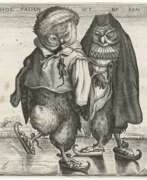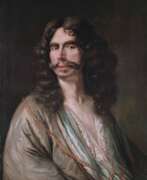Animalists 17th century


Elias Baeck called "Heldenmuth", was a German painter and engraver from Augsburg. Baeck worked for some time in Rome, then in Laybach, but finally returned to Augsburg, where he died in 1747. His chief works — both in painting and engraving — were portraits and landscapes. His engravings are sometimes signed "E.B.a.H.", standing for "Elias Baeck, alias Heldenmuth".


Abraham Bloemaert was a Dutch painter, draughtsman, and printmaker from the Golden Age of Dutch painting, one of the founders of the Guild of St. Luke in Utrecht. Bloemart was a caravagist. He painted mainly landscapes, mythological and biblical scenes, and pastoral works.
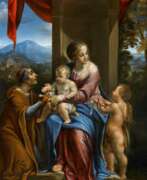

Angelo Caroselli was an Italian painter, born and active during the Baroque period, primarily in Rome. Known for his eclectic style, Caroselli's work was significantly influenced by Caravaggio, evident in the naturalism and chiaroscuro that marked his compositions. His subject matter often included colorful characters from contemporary Rome, scenes of witchcraft, musicians, and genre scenes reflective of the Caravaggisti, a group of artists who followed Caravaggio's stylistic approach. Caroselli's ability to blend allegories, religious works, and portraits with genre scenes showcased his search for originality and a unique narrative voice within the Baroque movement.
Angelo Caroselli's career was marked by his versatility as not only a painter but also an art restorer, copyist, and possibly a forger. This breadth of skills contributed to the diverse body of work he left behind, which ranged from scenes of everyday life to complex allegorical compositions. His works often depicted the lower echelons of society, including musicians, card players, and prostitutes, infused with a potent naturalism that brought these figures to life against the backdrop of 17th-century Rome.
Despite his adherence to Caravaggesque forms and themes, Angelo Caroselli's work also displayed 'archaicising' elements, which some art historians view as a conscious departure from the dominant Baroque style of his time. This aspect of his work, along with his skill in copying the works of ancient masters, highlights a deliberate exploration of and departure from the prevailing artistic norms, contributing to the unique place he occupies in Baroque art history.
Notably, Caroselli's influence extended beyond Italy, affecting the work of other Caravaggisti, including the Lucchese painter Pietro Paolini and the Dutch painter Dirck van Baburen. This cross-cultural impact underscores the broader significance of Caroselli's work within the Baroque period and its enduring influence on subsequent generations of artists.
His legacy includes several known works that are housed in prestigious institutions and collections worldwide, exemplifying the enduring appeal and historical importance of his artistic contributions. Among these, "The Plague at Ashdod (after Poussin)" stands out as a significant piece, reflecting his capability to engage with and reinterpret the works of his contemporaries and predecessors.
For collectors and experts in art and antiques, Caroselli's oeuvre offers a fascinating glimpse into the Baroque period's complexity, characterized by a blend of innovation, tradition, and a deep engagement with the human condition. His work remains a testament to the vibrancy and dynamism of 17th-century Italian art, inviting ongoing exploration and appreciation.
To stay updated on new discoveries, sales, and auction events related to Angelo Caroselli, sign up for our newsletter. This subscription ensures you're the first to know about the latest findings and opportunities to acquire works by or related to Angelo Caroselli, catering specifically to enthusiasts and collectors of historical art and antiques.


Marmaduke Cradock was an English painter of birds and animals.
Sketches in the collection of the British Museum indicate that he based at least some of the birds in his paintings on drawings from life. He tended to paint domestic birds and common wild species, rather than the exotic varieties favoured by some other artists. He sometimes introduced elements of drama such as attacks by predatory animals into his bird paintings, a feature shared with the works of Francis Barlow.


Gijsbert d'Hondecoeter was a Dutch landscape and animalier painter.
Hondecoeter belonged to a family of painters. His father was Gillis d'Hondecoeter and his son was Melchior d'Hondecoeter. Hondecoeter primarily painted works of barnyard fowl. Some of his works can be found at the Rijksmuseum Amsterdam. He became a member of the Guild of St. Luke in Utrecht in 1629. After he died in 1653, his brother-in-law and artist Jan Baptist Weenix continued the training of his son Melchior.
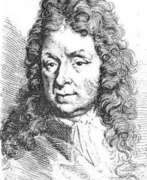

Melchior d'Hondecoeter was Dutch animalier painter, was born in Utrecht and died in Amsterdam. After the start of his career, he painted virtually exclusively bird subjects, usually exotic or game, in park-like landscapes. Hondecoeter's paintings featured geese (brent goose, Egyptian goose and red-breasted goose), fieldfares, partridges, pigeons, ducks, northern cardinal, magpies and peacocks, but also African grey crowned cranes, Asian sarus cranes, Indonesian yellow-crested cockatoos, an Indonesian purple-naped lory and grey-headed lovebirds from Madagascar.


Cesare Dandini was an Italian painter of the Baroque period, active mainly in his native city of Florence. He was the older brother of the painter Vincenzo Dandini. He enrolled in 1621 in the Accademia del Disegno. His style has the polish and attention to draughtsmanship and design characteristic of Florentines like Carlo Dolci.


Marcus de Bye (sometimes spelt de Bie or de Bije) was a Dutch painter and engraver. He learnt to paint under Jacob van der Does, and produced some landscapes with animals in the style his teacher, but he is best known for his etchings of animals, after the designs of Paulus Potter and Markus Gerard II. Member of Confrerie Pictura.
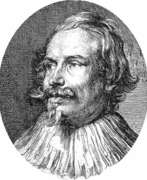

Paul de Vos was a Flemish Baroque painter and a member of the Guild of St. Luke in Antwerp.
Paul de Vos was the younger brother of Cornelis de Vos and specialized in hunting scenes with dogs, depicting various animals and birds. His skill in this genre was valued and he collaborated with Rubens in depicting animals. De Vos's paintings were highly regarded both in Spain and at other European courts.
De Vos enjoyed the patronage of Spain's influential aristocrats and received many commissions from them. In 1637-1638 he worked with Rubens and Snyders on the decoration of Spanish royal residences.


Jan Jansz. den Uyl was a painter of the Dutch Golden Age. He very much specialized in the form of still life known as the breakfast piece, or, in the elaborate style of painters like den Uyl, banquet pieces (banketjestukken). He also painted landscapes and animal paintings.


Karel Dujardin was a Dutch painter and printmaker of the Golden Age of Dutch painting.
He studied with Klaas Berchem and Paulus Potter, traveled to Italy, and lived in Lyon. In 1656 he participated in the founding of the Pictura Society in The Hague.
Dujardin painted mostly Italian landscapes, genre scenes, including scenes from rural life, portraits of elegant people and historical paintings.
Many of Dujardin's works are in the Louvre, the Hermitage (St. Petersburg), as well as in Amsterdam, The Hague, Kassel, and Berlin.


Wenceslaus Hollar, born on July 13, 1607, in Prague, was a Bohemian artist acclaimed for his etchings and engravings. His journey in art began in Germany, where he studied under the engraver Matthäus Merian. Hollar's career flourished when he moved to England, where he worked for various print sellers and publishers, including the notable John Ogilby and antiquarian Sir William Dugdale.
Hollar is remembered for his intricate and detailed works that include over 2,000 pieces, ranging from classical and historical subjects to portraits, costumes, and topographical scenes. His skill in translating texture into the etched medium was unparalleled, even as he lost most of the sight in one eye. Some of his most significant works include "Views of London," created after the Great Fire of London in 1666, which became valuable historical records of the city.
Tragically, Hollar's life was marked by hardships, including financial struggles and the loss of his young son to the plague. Despite these challenges, his dedication to his craft never waned. He continued to produce high-quality works until his death on March 25, 1677, in extreme poverty. Today, his works are held in high regard and are preserved in prestigious collections such as the British Museum in London and the National Gallery in Prague.
Hollar's legacy is a testament to his exceptional talent and his ability to capture the essence of his subjects with precision and depth. His works continue to be a rich source of historical and artistic knowledge, particularly for collectors, auctioneers, and experts in art and antiques.
For those interested in the remarkable etchings and engravings of Wenceslaus Hollar, staying informed about exhibitions and sales of his work can offer valuable insights into his unique artistic perspective.


Albert Jansz. Klomp was a Dutch painter of the Golden Age of Dutch painting who specialised in painting rural landscapes with animals.
Albert Klomp's paintings resemble those of Paulus Potter. Both artists have similar subjects and style, and Klomp's work has been erroneously attributed to Potter in the past.
Klomp's typical pastoral landscapes can be seen in many of the world's museums.


Paulus Potter was a Dutch painter who specialized in animals within landscapes, usually with a low vantage point.
Before Potter died of tuberculosis at the age of 28 he succeeded in producing about 100 paintings, working continuously.




Luisa Ignacia Roldán Villavicencio, known as La Roldana, was a Spanish sculptress of the Baroque period and the first female sculptor in Spain about whom there is verified lore. In the Museum of the Latin American Society, Roldán is described as "one of the few female artists who had their own workshop outside the convent in Golden Age Spain". Her father Pedro Roldán was also a sculptor from Seville.
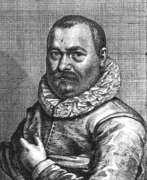

Roelant Savery was a Flanders-born Dutch Golden Age painter.
Savery primarily painted landscapes in the Flemish tradition of Gillis van Coninxloo, often embellished with many meticulously painted animals and plants, regularly with a mythological or biblical theme as background. He also painted multiple flower still lifes; bouquets in stone niches, sometimes with lizards such as Flowers with Two Lizards, insects or fallen petals and regarded as his best work.
His unique style of painting, related to the then reigning Mannerism, has been highly popular with collectors and can be found in many museums in Europe and North America. His preparatory drawings are also valued highly.


Massimiliano Soldani or Massimiliano Soldani Benzi was an Italian baroque sculptor and medallist, mainly active in Florence. Soldani developed into one of the finest bronze casters of his time in Europe. Though first specialising as a medallist, Soldani also produced bronze reliefs, bronze vases and free-standing figures and busts.


Lazzaro Tavarone was an Italian painter of the late-Renaissance and Mannerist period, active mainly in his native Genoa and in Spain. He was the pupil of the painter Luca Cambiasi. Tavarone accompanied Cambiaso to Spain in 1583, and helped decorate the Escorial for the Spanish King, including the chaotic battle painting of Battle of La Higueruela. He returned to Genoa in 1594, where he became well known both as portrait and history painter.


Jan van Huchtenburgh was a Dutch painter of the Dutch Golden Age who specialised in battle scenes and landscapes.
Jan van Huchtenburgh was known for his ability to create dramatic and dynamic battle scenes, often depicting historical events of the 17th and 18th centuries. His work is noted for its precision and attention to detail, as well as his use of light and shadow to create a sense of depth and drama.
In addition to battle scenes, Huchtenburg was also a skilled landscape painter. He often depicted scenes of the Dutch countryside with rolling hills, winding rivers and expansive skies.
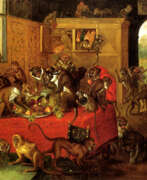



Izaak (Isaac) van Oosten was a Flemish Baroque landscape and cabinet painter active in Antwerp.
His landscapes are simple with open spaces and mostly hilly landscapes typically filled with a pond or road and several clusters of trees. There is an overall sense of gentleness and calm in these compositions. An even, gentle light spreads over the entire painting and the trees are untouched by the wind. A number of his landscapes have a Mediterranean flavour.
Works by van Oosten can be found in the collections of the Uffizi, the Museo del Prado, the Hermitage Museum, the Musée des Beaux-Arts d'Orléans, the Museum of Fine Arts of Rennes, the Toledo Museum of Art and other museums.


Philips Wouwerman was a distinguished Dutch painter. Renowned for his equestrian scenes, landscapes, and battle depictions, Wouwerman's work embodies the richness of the Dutch Golden Age of painting. He initially trained under his father, Paulus Wouwerman, and possibly with the celebrated artist Frans Hals, showcasing a deep engagement with the artistic milieu of Haarlem.
Wouwerman's career is marked by a prolific output, with about 570 of his works confidently attributed to him today. His oeuvre was once thought to include up to 1200 pieces, a testament to his influence and the extensive body of followers and imitators he inspired across Europe. His brothers, Jan and Pieter Wouwerman, were also painters who are sometimes confused with Philips due to their stylistic similarities.
Philips Wouwerman's paintings are celebrated for their dynamic composition and intricate detail, particularly his treatment of horses which has been a subject of admiration across centuries. His landscapes often feature Italianate settings, despite no concrete evidence suggesting he ever visited Italy. His style was notably influenced by Pieter van Laer, another Haarlem artist with a significant Italian experience, from whom Wouwerman might have acquired sketches and studies.
For art collectors and experts, Wouwerman's work provides a fascinating glimpse into 17th-century Dutch culture, offering scenes filled with vibrancy and life that capture the viewer's imagination. His paintings can be found in prestigious museums worldwide, including the Rijksmuseum in Amsterdam, The National Gallery in London, and the Kunsthistorisches Museum in Vienna, showcasing his widespread acclaim and the enduring legacy of his art.
For those interested in exploring the captivating world of Philips Wouwerman and staying informed about new discoveries, sales, and auction events related to his work, signing up for updates is highly recommended. This ensures access to the latest information and opportunities related to one of the Dutch Golden Age's most versatile and prolific artists.




















